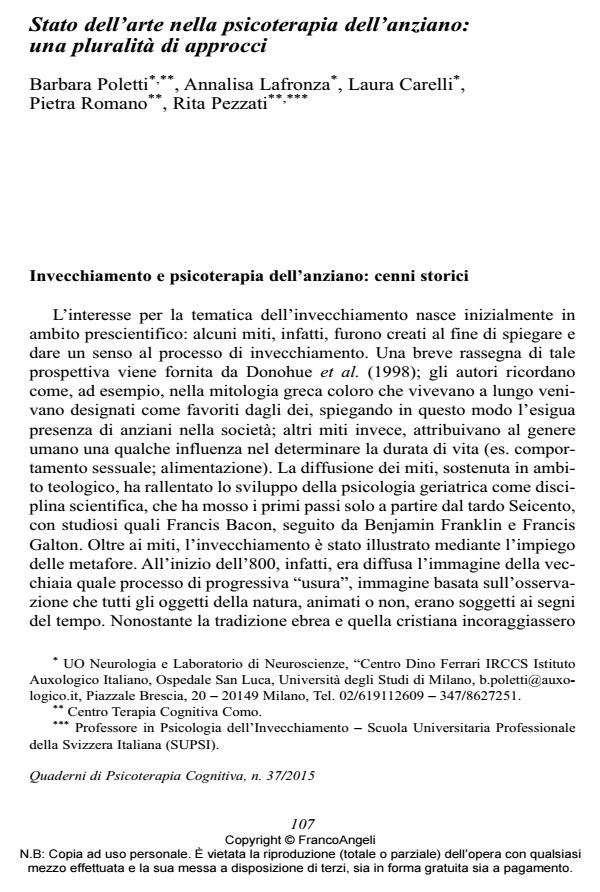Stato dell’arte nella psicoterapia dell’anziano: una pluralità di approcci
Titolo Rivista QUADERNI DI PSICOTERAPIA COGNITIVA
Autori/Curatori Barbara Poletti, Annalisa Lafronza, Laura Carelli, Pietra Romano, Rita Pezzati
Anno di pubblicazione 2015 Fascicolo 2015/37
Lingua Italiano Numero pagine 60 P. 107-166 Dimensione file 283 KB
DOI 10.3280/QPC2015-037007
Il DOI è il codice a barre della proprietà intellettuale: per saperne di più
clicca qui
Qui sotto puoi vedere in anteprima la prima pagina di questo articolo.
Se questo articolo ti interessa, lo puoi acquistare (e scaricare in formato pdf) seguendo le facili indicazioni per acquistare il download credit. Acquista Download Credits per scaricare questo Articolo in formato PDF

FrancoAngeli è membro della Publishers International Linking Association, Inc (PILA)associazione indipendente e non profit per facilitare (attraverso i servizi tecnologici implementati da CrossRef.org) l’accesso degli studiosi ai contenuti digitali nelle pubblicazioni professionali e scientifiche
Il presente lavoro intende illustrare i principali approcci psicoterapici presenti, rivolti al trattamento del disagio psicologico nell’anziano. Dopo una breve presentazione della psicologia dell’invecchiamento, nella sua evoluzione storica tra miti e scienza, e della cornice teorica e storico-culturale in cui si inserisce la psicoterapia dell’anziano, vengono illustrate le caratteristiche del setting e delle modalità di intervento, nonché le evidenze sperimentali relative agli studi di efficacia, nei principali approcci della terapia psicodinamica, cognitivocomportamentale e cognitivo-costruttivista. Vengono inoltre brevemente descritti ulteriori approcci significativi di intervento clinico, quali la terapia interpersonale e la Mindfullness che hanno contribuito a realizzare adattamenti ai classici modelli di intervento per la cura dell’anziano, e la Life Review Therapy. Viene infine presentata una sintesi delle evidenze empiriche circa l’efficacia di alcuni approcci adattati a persone affette da declino cognitivo, presenti in quadri di Mild Cognitive Impairment o demenza, riportando tra questi un intervento specificatamente rivolto a persone affette da demenza di grado moderato-severo, quale la Doll Therapy. Dai lavori descritti emerge un quadro complesso ed articolato, dal quale si evince l’esigenza, trasversale ai diversi approcci, di adattare gli interventi psicoterapici alle caratteristiche peculiari ed ai bisogni specifici della persona anziana, al fine di valorizzarne risorse e potenzialità.
Parole chiave:Psicoterapia dell’anziano, psicoterapia costruttivista relazionale, psicoterapia cognitivo-comportamentale, psicoanalisi
Barbara Poletti, Annalisa Lafronza, Laura Carelli, Pietra Romano, Rita Pezzati, Stato dell’arte nella psicoterapia dell’anziano: una pluralità di approcci in "QUADERNI DI PSICOTERAPIA COGNITIVA" 37/2015, pp 107-166, DOI: 10.3280/QPC2015-037007